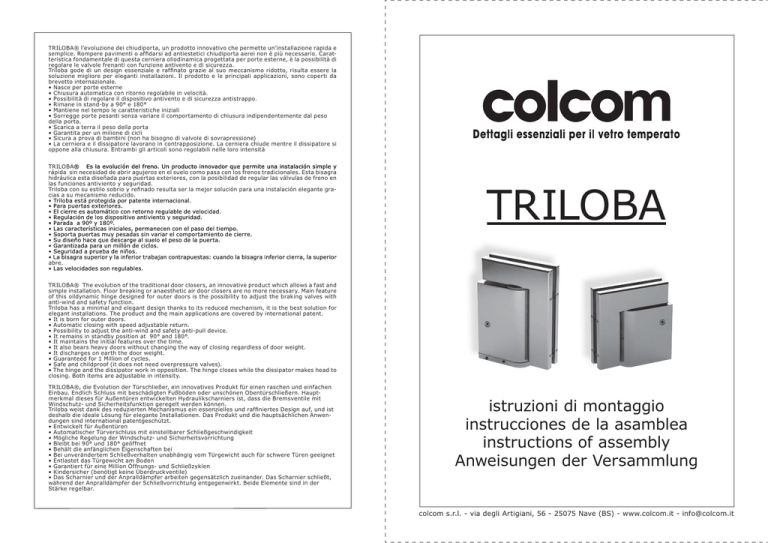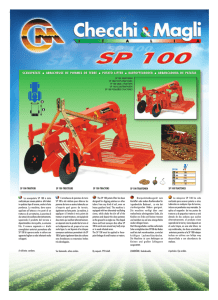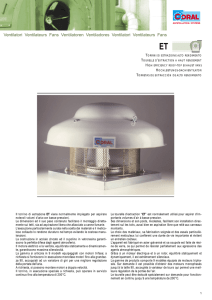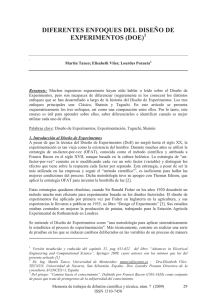triloba - Minusco
Anuncio

TRILOBA® l’evoluzione dei chiudiporta, un prodotto innovativo che permette un’installazione rapida e semplice. Rompere pavimenti o affidarsi ad antiestetici chiudiporta aerei non è più necessario. Caratteristica fondamentale di questa cerniera oliodinamica progettata per porte esterne, è la possibilità di regolare le valvole frenanti con funzione antivento e di sicurezza. Triloba gode di un design essenziale e raffinato grazie al suo meccanismo ridotto, risulta essere la soluzione migliore per eleganti installazioni. Il prodotto e le principali applicazioni, sono coperti da brevetto internazionale. • Nasce per porte esterne • Chiusura automatica con ritorno regolabile in velocità. • Possibilità di regolare il dispositivo antivento e di sicurezza antistrappo. • Rimane in stand-by a 90° e 180° • Mantiene nel tempo le caratteristiche iniziali • Sorregge porte pesanti senza variare il comportamento di chiusura indipendentemente dal peso della porta. • Scarica a terra il peso della porta • Garantita per un milione di cicli • Sicura a prova di bambini (non ha bisogno di valvole di sovrapressione) • La cerniera e il dissipatore lavorano in contrapposizione. La cerniera chiude mentre il dissipatore si oppone alla chiusura. Entrambi gli articoli sono regolabili nelle loro intensità TRILOBA® ® Es la evolución del freno. Un producto innovador que permite una instalación simple y rápida sin necesidad de abrir agujeros en el suelo como pasa con los frenos tradicionales. Esta bisagra hidráulica esta diseñada para puertas exteriores, con la posibilidad de regular las válvulas de freno en las funciones antiviento y seguridad. Triloba con su estilo sobrio y refinado resulta ser la mejor solución para una instalación elegante gracias a su mecanismo reducido. • Triloba está protegida por patente internacional. • Para puertas exteriores. • El cierre es automático con retorno regulable de velocidad. • Regulación de los dispositivo antiviento y seguridad. • Parada a 90º y 180º. • Las características iniciales, permanecen con el paso del tiempo. • Soporta puertas muy pesadas sin variar el comportamiento de cierre. • Su diseño hace que descarge al suelo el peso de la puerta. • Garantizada para un millón de ciclos. • Seguridad a prueba de niños. • La bisagra superior y la inferior trabajan contrapuestas: cuando la bisagra inferior cierra, la superior abre. • Las velocidades son regulables. TRILOBA TRILOBA® The evolution of the traditional door closers, an innovative product which allows a fast and simple installation. Floor breaking or anaesthetic air door closers are no more necessary. Main feature of this oildynamic hinge designed for outer doors is the possibility to adjust the braking valves with anti-wind and safety function. Triloba has a minimal and elegant design thanks to its reduced mechanism, it is the best solution for elegant installations. The product and the main applications are covered by international patent. • It is born for outer doors. • Automatic closing with speed adjustable return. • Possibility to adjust the anti-wind and safety anti-pull device. • It remains in standby position at 90° and 180°. • It maintains the initial features over the time. • It also bears heavy doors without changing the way of closing regardless of door weight. • It discharges on earth the door weight. • Guaranteed for 1 Million of cycles. • Safe and childproof (it does not need overpressure valves). • The hinge and the dissipator work in opposition. The hinge closes while the dissipator makes head to closing. Both items are adjustable in intensity. TRILOBA®, die Evolution der Türschließer, ein innovatives Produkt für einen raschen und einfachen Einbau. Endlich Schluss mit beschädigten Fußböden oder unschönen Obentürschließern. Hauptmerkmal dieses für Außentüren entwickelten Hydraulikscharniers ist, dass die Bremsventile mit Windschutz- und Sicherheitsfunktion geregelt werden können. Triloba weist dank des reduzierten Mechanismus ein essenzielles und raffiniertes Design auf, und ist deshalb die ideale Lösung für elegante Installationen. Das Produkt und die hauptsächlichen Anwendungen sind international patentgeschützt. • Entwickelt für Außentüren • Automatischer Türverschluss mit einstellbarer Schließgeschwindigkeit • Mögliche Regelung der Windschutz- und Sicherheitsvorrichtung • Bleibt bei 90° und 180° geöffnet • Behält die anfänglichen Eigenschaften bei • Bei unverändertem Schließverhalten unabhängig vom Türgewicht auch für schwere Türen geeignet • Entlastet das Türgewicht am Boden • Garantiert für eine Million Öffnungs- und Schließzyklen • Kindersicher (benötigt keine Überdruckventile) • Das Scharnier und der Anpralldämpfer arbeiten gegensätzlich zueinander. Das Scharnier schließt, während der Anpralldämpfer der Schließvorrichtung entgegenwirkt. Beide Elemente sind in der Stärke regelbar. istruzioni di montaggio instrucciones de la asamblea instructions of assembly Anweisungen der Versammlung colcom s.r.l. - via degli Artigiani, 56 - 25075 Nave (BS) - www.colcom.it - info@colcom.it 8201 - TRILOBA® • Cerniera oleodinamica con regolazione delle velocità di chiusura dell’anta. Stop a 0° +90° -90°. • Bisagra automática hidráulica inferior con regulación de velocidad de cierre de la puerta. Stop a 0°, + 90°, -90°. • Oildynamic hinge with adjustment of the closing speed of the door. Stop at 0° +90° -90°. • Hydraulisches Scharnier mit Regelung der Türschließgeschwindigkeit. Stopp bei 0° +90° -90°. 10mm 12mm 1200mm 150kg 8202 - TRILOBA® • Dissipatore oleodinamico con regolazione del intensità frenante. • Bisagra automática hidráulica superior con dispositivo de frenado. • Control valve of brake. • Hydraulischer Anpralldämpfer mit Regelung der Bremsstärke. 10mm 12mm 1200mm 150kg 1. 2. 3. 4. 5. 6. 7. 8. Fissare le staffe angolari (pavimento/muro art.8201; soffitto/muro art.8202) e successivamente infilarvi i corpi. Lasciare allentati i grani della cerniera inferiore (1, 2a, 2b e 3a e 3b). Serrare il grano 5 e poi il grano 4 del dissipatore. Pinzare il vetro mediante le apposite piastre e viti. Effettuare l’allineamento della porta sui grani 2a e 2b sino a serrarli completamente. A regolazione completata bloccare serrando i grani 3a e 3b. Aprire la porta a 90° e serrare quindi il grano 1. Richiudere la porta. Regolare le velocità di chiusura e di dissipazione mediante gli appositi ugelli (vedi sotto). Applicare i carters di copertura a pressione. REGOLAZIONE DEGLI UGELLI • Cerniera inferiore (art.8201) ACCELERAZIONE = SVITARE, DECELERAZIONE = AVVITARE Aprire la porta in posizione di apertura 60°-70°, poi lasciarla libera e valutare la velocità con cui si chiude: svitando l’ugello di regolazione e ripetendo l’operazione sopra, impostare la velocità di chiusura desiderata. ATTENZIONE: APERTURE VIOLENTE OLTRE I 95° POTREBBERO CAUSARE LO SCARDINAMENTO. È CONSIGLIABILE L’APPLICAZIONE DI UN FERMAPORTA. • Dissipatore superiore (art.8202) MINORE FORZA FRENANTE = SVITARE, MAGGIORE FORZA FRENANTE = AVVITARE Per regolare il freno in chiusura aprire la porta in posizione aperta 60°-70° accompagnando la porta in chiusura questa deve risultare libera, mentre chiudendo in maniera brusca quello che si dovrà percepire sarà una leggera resistenza. ATTENZIONE: NON REGOLARE IL FRENO FRENANDO ECCESSIVAMENTE LA PORTA. LA SUA FUNZIONE E’ QUELLA DI RALLENTATE LA CHIUSURA QUALORA LA PORTA FOSSE SPINTA DAL VENTO. 5 N.B. ATTENZIONE! NON SVITARE MAI DEL TUTTO GLI UGELLI (FUORI USCITA OLIO IN PRESSIONE!). NON RISPONDIAMO DI EVENTUALI RESI CON UGELLO SVITATO. 1. 2. 4 3. 4. 5. 6. 7. 8. Fijar el ángulo de ensamblaje (suelo/pared artículo 8201 techo/pared artículo 8202); después montar los cuerpos. Aflojar los tornillos prisioneros de la bisagra inferior (1,2a,2b,3a,3b). Cerrar el tornillo prisionero 5 y después el 4 de la bisagra superior. Pinzar el vidrio mediante las tapas y los tornillos. Alinear la puerta con los tornillos prisioneros 2a y 2b hasta cerrarlos completamente. Con la regulación completa, bloquear los prisioneros 3a y 3b. Abrir la puerta a 90º y cerrar el tornillo prisionero 1. Cierrar la puerta. Regular la velocidad de cierre y de frenado mediante los tornillos de regulación (véase más abajo). Fijar a presión las tapas embellecedoras. REGULACIÓN DE LAS VÁLVULAS • Bisagra inferior (art.8201) mayor aceleraion = desatornillar, menor acelerazion = atornillar Cada bisagra dispone de un tornillo allen situado a la vista en uno de los laterales. Para facilitar la regulación de cierre del sistema, Colcom entrega la bisagra inferior(8201), con su tornillo de regulación completamente atornillado. APERTURA VIOLENTA ADEMÁS DE 95°, PODRIA CAUSAR DAÑO. ACONSEJAMOS UTILIZAR UN FIJA PUERTA. • Bisagra superior (art.8202) menor fuerza de frenado = desatornillas, mayor fuerza de frenado = atornillar Por el contrario la bisagra superior (8202), se entrega con el tornillo de regulación abierto. Una vez instalado el sistema Triloba, procedemos a su regulación. Abrimos la puerta 60º-70º, desatornillamos 1/8 de vuelta, (aprox) de la bisagra inferior(8201), dejamos cerrar la puerta y observamos su velocidad de cerrado. La puerta debe traspasar el punto 0º, 25-30 cm. (aprox). Hemos dado a la puerta una velocidad de cerrado excesiva. Ahora corregimos la velocidad de cerrado, atornillando la bisagra superior (8202), hasta que consigamos que nuestra puerta quede parada en el punto 0º. Queremos dejar claro que el sistema Triloba se basa en un equilibrio entre la velocidad que imprime la bisagra inferior (8201) para el cierre de la puerta y la acción contraria de frenado que aporta la bisagra superior(8202). Los tornillos de regulación del sistema de cierre Triloba, no se deben desatornillar totalmente, el aceite puede salir por presión. N.B. COLCOM NO REPONE LAS BISAGRAS CON LA TOBERA DE AJUSTE DESATORNILLADA. APERTURA VIOLENTA ADEMÁS DE 95°, PODRIA CAUSAR DAÑO. ACONSEJAMOS UTILIZAR UN FIJA PUERTA. 1. 2. 3. 4. 5. 6. 7. 8. Fix the angular brackets (floor/wall item 8201; ceiling/wall item 8202) and then thread the bodies. Maintain the dowels of bottom hinge (1, 2a, 2b and 3a and 3b) loosen up. Fasten the dowel nr. 5 and then dowel nr. 4 of dissipator. Clamp the glass using the appropriate plates and screws. Align the door through the dowels 2a and 2b since they are completely fastened. When the adjustment is completed, block fastening dowels 3a and 3b. Open the door at 90° and fasten dowel 1. Close again the door. Adjust the speed of closing and of dissipation using the appropriate valves (see below). Apply pressure covering timing case. ADJUSTMENT OF THE NOZZLES • Bottom hinge (item code 8201) ACCELERATION =LOOSEN , DECELERATION = TIGHTEN Open the door at the 60°-70° position , turn loose and determine the speed which is closing: in order to reach the desidered closing speed , loose the adjustment nozzle and repeat the above mentioned operation. NOTE : ATTENTION! FURTHER THAN 95° COULD UNHINGE THE DOOR. WE SUGGEST TO INSTALL A DOOR STOP. • Upper dissipator (item code 8202) LOWER BRAKE-FORCE = TO LOOSEN , LARGER BRAKE-FORCE = TO TIGHTEN In order to adjust the brake while closing , open the door at the 60°-70° position; support the door while closing , the door will be free, while pulling in offhand way, You will feel a lightly resistance. ATTENTION : DO NOT ADJUST THE BRAKE EXCESSIVELY . IT FUNCTION IS TO DECREASE THE CLOSING IF THE DOOR IS PUSHED BY THE WIND. NOTE : ATTENTION! DO NOT NEVER LOOSEN THROUGH AND THROUGH THE NOZZELS (OIL LEAKAGE ON PRESSION) AS WE ARE NOT LIABLE FOR ANY RETURN BY LOOSING NOZZLE. 1. 2. 3. 4. 5. 6. 7. 8. Die Winkel (Fußboden/Wand Art. 8201; Decke/Wand Art. 8202) fixieren und danach die Körper einsetzen. Die Stifte des unteren Scharniers (1, 2a, 2b, 3a und 3b) locker lassen. Den Stift 5 und danach den Stift 4 des Anpralldämpfers festziehen. Die Glasscheiben mit den entsprechenden Montageplatten und Schrauben fixieren. Die Türausrichtung über die Stifte 2a und 2b vornehmen, bis diese komplett festgezogen sind. Nach der erfolgten Regelung die Stifte 3a und 3b festziehen. Die Tür auf 90° öffnen und den Stift 1 festziehen. Die Tür wieder schließen. Die Schließgeschwindigkeit und die Bremskraft über die entsprechenden Düsen regeln (siehe unten). Die Abdeckungen aufstecken REGELUNG DER DÜSEN • UNTERES SCHARNIER (ART. 8201) BESCHLEUNIGUNG = AUSSCHRAUBEN, VERZÖGERUNG = EINSCHRAUBEN DIE TÜR SOLL ZU 60°-70° GEÖFFNET SEIN, DANN DIE TÜR FREI LASSEN UND DIE GESCHWINDIGKEIT DER SCHLIESSUNG . UM DIE GEWÜNSCHTE GESCHWINDIGKEIT DER SCHLIESSUNG ZU ERREICHEN, DIE REGELDÜSE AUSSCHRAUBEN UND DIE OBEN GENANNTE AKTION WIEDERHOLEN. ACHTUNG : HEFTIGE ÖFFNUNGEN MEHR ALS 95° KÖNNTEN DIE TÜR AUSHEBEN. WIR SCHLAGEN DIE INSTALLIERUNG EINES TÜRHALTERS VOR. • OBERER ANPRALLSDÄMPFER (ART. 8202) GERINGERE BREMSKRAFT = AUSSCHRAUBEN, HÖHERE BREMSKRAFT = EINSCHRAUBEN UM DIE SCHLIESSBREMSE ZU REGELN, DIE TÜR ZU 60°-70° ÖFFNEN BEIM BEGLEITEN DER TÜR WÄHREND DES SCHLIESSVORGANGS, SIE WIRD FREI SEIN, WÄHREND BEI RUCKARTIGEN SCHLIESSEN EINE GEGENWIRKUNG SPÜRBAR SEIN WIRD. DIESE GEGENWIRKUNG WIRD HÖHER SEIN, WENN DIE REGELDÜSE KOMPLETT EINGESCHRAUBT WIRD UND UMGEKEHRT WENN MAN DIE REGELDÜSE AUSSCHRAUBT. ACHTUNG : DIE BREMSE NICHT ÜBERMÄSSIG EINSTELLEN. SIE DIENT DAZU, DAS SCHLIESSEN ZU VERLANGSAMEN, WENN DIE TÜR VOM WIND GEDRÜCKT WIRD. N.B.: ACHTUNG! DIE DÜSEL NIE KOMPLETT AUSSCHRAUBEN, SONST WIRD DAS ÖL UNTER DRUCK RAUS KOMMEN!! IN DIESEM FALL WERDEN WIR FÜR RETUNRLIEFERUNGEN MIT AUSGESCHRAUBTER DÜSE NICHT HAFTEN. istruzioni_Triloba.indd 2 25-06-2009 9:40:05



